

 The Accurate Reloading Forums
The Accurate Reloading Forums  THE ACCURATE RELOADING.COM FORUMS
THE ACCURATE RELOADING.COM FORUMS  Guns, Politics, Gunsmithing & Reloading
Guns, Politics, Gunsmithing & Reloading  Military & Military Surplus
Military & Military Surplus  French MAS 1940, the most modern semi auto rifle in WW2
French MAS 1940, the most modern semi auto rifle in WW2Go  | New  | Find  | Notify  | Tools  | Reply  |  |
| One of Us |
Too bad it did not enter into production much earlier. The first french semi auto prototype was built by two brothers, Clair, in Saint Etienne in 1888, only two years after the adoption of the Lebel and its smokeless 8 mm round. In 1892, it is decided to launch large scale studies. 20 rifles are competing after 1900 and the Meunier is adopted in 1913 but it is not produced when WW1 breaks. In 1917, the RSCG rifle is adopted and 80 000 reaches the front line in 1918. the RSCG 1918 is adopted but only a small batch is produced. In 1922, the STAT produces a prototype very close to the MAS 35 that will become the MAS 38 then MAS 38/39 before to be adopted as MAS 40. The MAS 40 is reborn as MAS 44 then modified as MAS 49 and finally as MAS 49/56. The MAS 54 bullpup is not adopted and will be the base of the FA MAS. The MAS 62 aka the French FAL will not be produced. (only a pre industrial batch of 300 pieces) One can dream of a french M14 20 years before the M14... 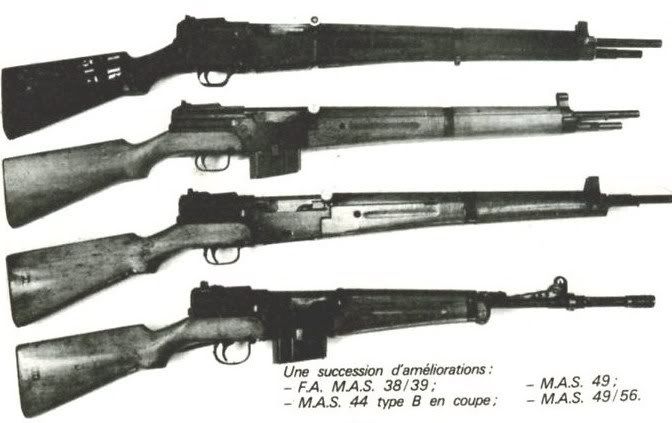 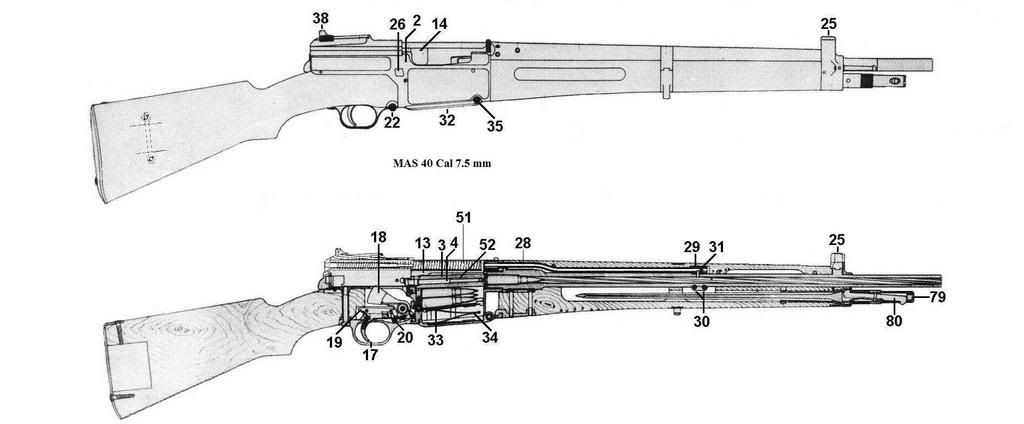 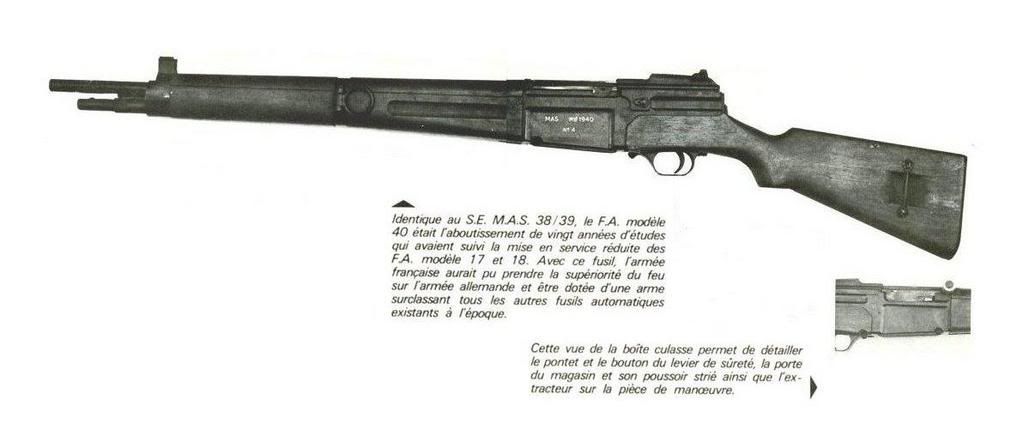  French soldier as he should have been after July 1940.. The first hundred rifles saw combat in May 1940, 50 with fixed magazine and 50 with detachable magazine.  | ||
|
| One of Us |
MAS 44, MAS 49   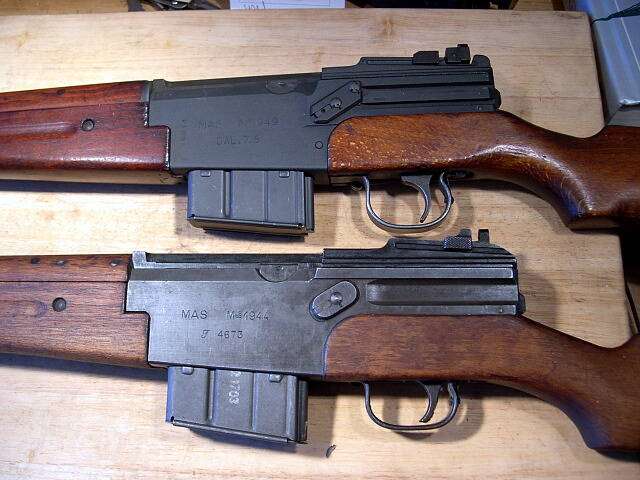 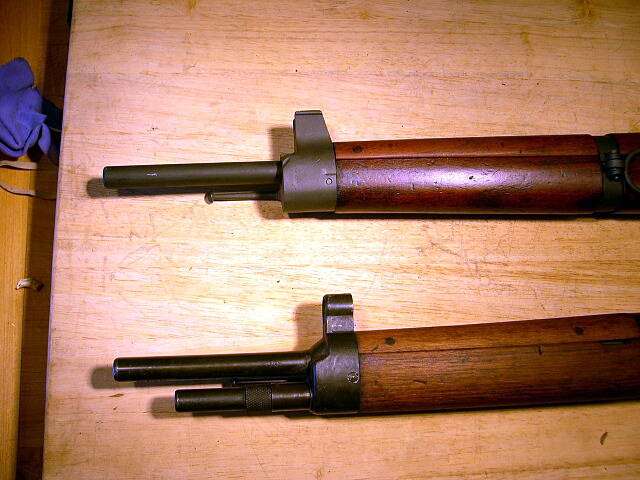   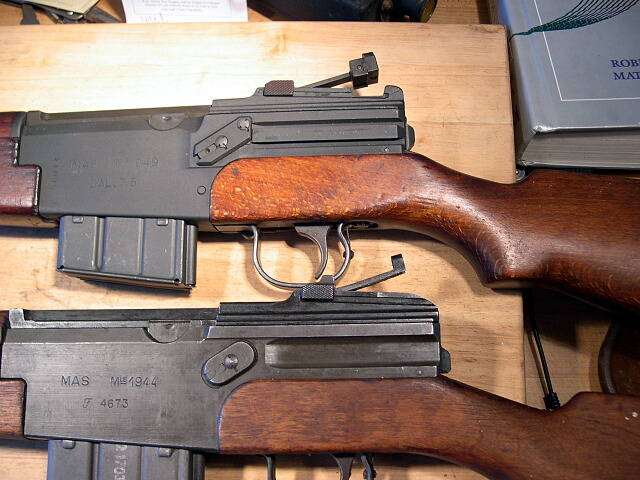   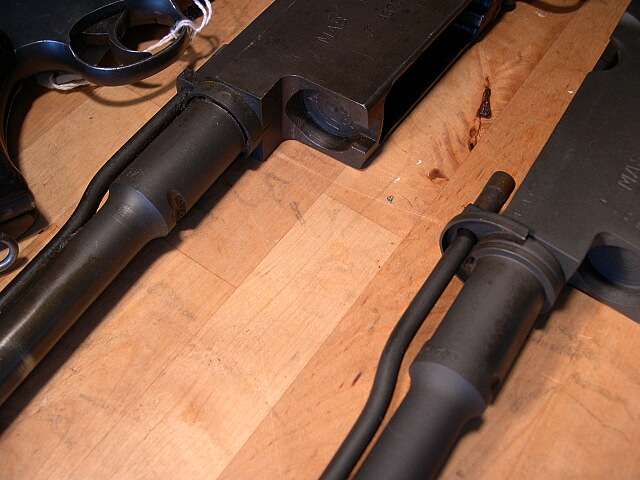 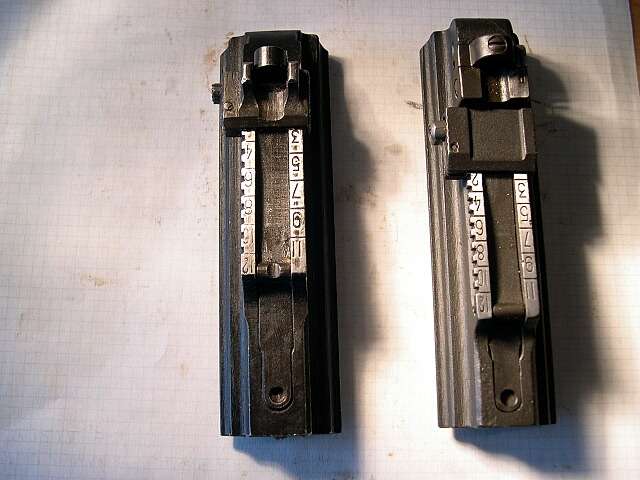 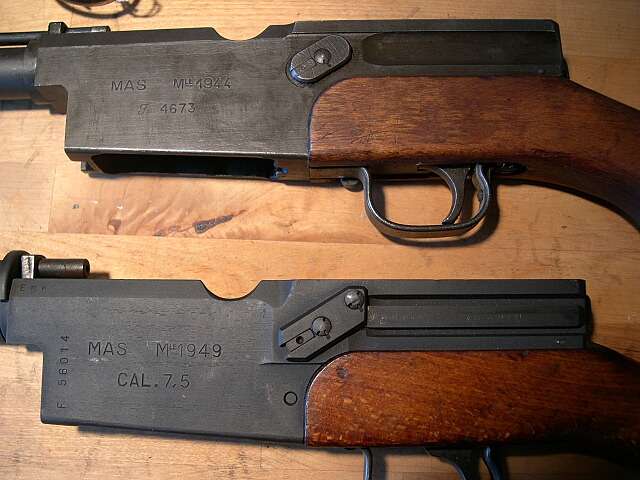 | |||
|
| one of us |
To quote a well known gunsmith by the name of Harold McFarland. "When worse military rifles are made, the French will make them" So how many Allied soldiers did the Germans kill using the captured Frog rifles? | |||
|
| One of Us |
Actually those are damn fine rifles, so are the bolt action models. If the French build some bad items, then how come their Exocet missile is still state of the art today? Not to add the Harrier jet, which I believe is one of their inventions. Joe | |||
|
| One of Us |
| |||
|
| One of Us |
| |||
|
| One of Us |
Well known....Really??? Never heard of the guy, But he doesn't sound particularly well informed. Enlighten us please what prevents the MAS'es from being excellent battle rifles? ---------------------------------------- If you waste your time a talkin' to the people who don't listen To the things that you are sayin' who do you thinks gonna hear And if you should die explainin' how the thing they complain about Or the things they could be changing who do you thinks gonna care Waylon Jennings | |||
|
| One of Us |
| |||
|
| One of Us |
Edmond, Saw that last night. Very impressive. Wish I had the money to buy it. Joe | |||
|
| One of Us |
This guy knows how to use a MAS 36 http://www.youtube.com/watch?v=hbXRpV09-ew | |||
|
| One of Us |
| |||
|
| one of us |
Edmund what is that projection on the left side of the receiver (in a diagonal position) in the middle for? 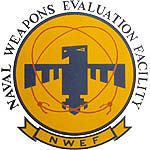 Doug Humbarger NRA Life member Tonkin Gulf Yacht Club 72'73. Yankee Station Try to look unimportant. Your enemy might be low on ammo. | |||
|
| one of us |
From my reading over the years I got the impression it was the French Light and medium machine guns that were not so hot. The Mat-49 subby was very good for its time. | |||
|
| One of Us |
Have a look https://forums.accuratereloading.com/eve/forums/a/tpc/f/7811043/m/953105667 This is the most stable, accurate, reliable LMG I know with the exception of the BAR. | |||
|
| One of Us |
I will scan my armourer's manuals when I have some time. This is the "coin d'appui" a hard tempered steel part that crosses the receiver. the bolt being a tilting part, rests on it when in its forward locked position. the size of this part determinates the headspace too since its thickness determinates the locking position. The FAL is a copy of this system. | |||
|
| One of Us |
An interesting conversion American way   French way    http://www.rdstactical.com/images_site_hk/armes_customs...1_large(somalie).jpg http://www.rdstactical.com/Documents/article_cible.pdf | |||
|
| One of Us |
PS: Coin d'appui the LMG 1924 works the same way but tilting upward  http://armesfrancaises.free.fr/FM%2024-29-dessin%20coupe-WEB.jpg http://armesfrancaises.free.fr/FM%2024-29-dessin%20m%E9canismes2.jpg http://armesfrancaises.free.fr/FM%2024-29-dessin%20ense...0d%E9verouill%E9.jpg http://armesfrancaises.free.fr/FM%2024-29-dessin%20ense...le%20verouill%E9.jpg http://armesfrancaises.free.fr/FM%2024-29-culasse%20en%20place-WEB.jpg http://armesfrancaises.free.fr/FM%2024-29-culasse%20en%20place-WEB-02.jpg From this site : http://armesfrancaises.free.fr/FM%20Mle%2024-29.html | |||
|
| One of Us |
Edmond, That conversion that resembles an AR15 is more then just interesting, it is just remarkable. Amazing even. Joe | |||
|
| One of Us |
IMNSHO, the best base to build an accurate reliable affordable semi auto sniper rifle. It sure looks great. | |||
|
| One of Us |
Here they are. Technical drawings, coin d'appui et feuillure. 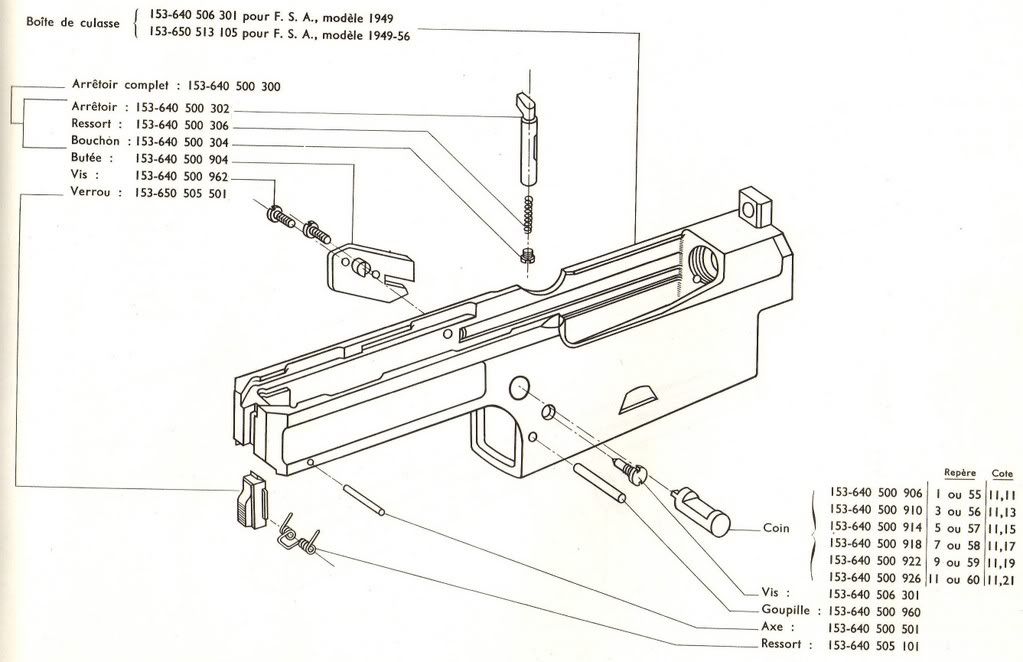 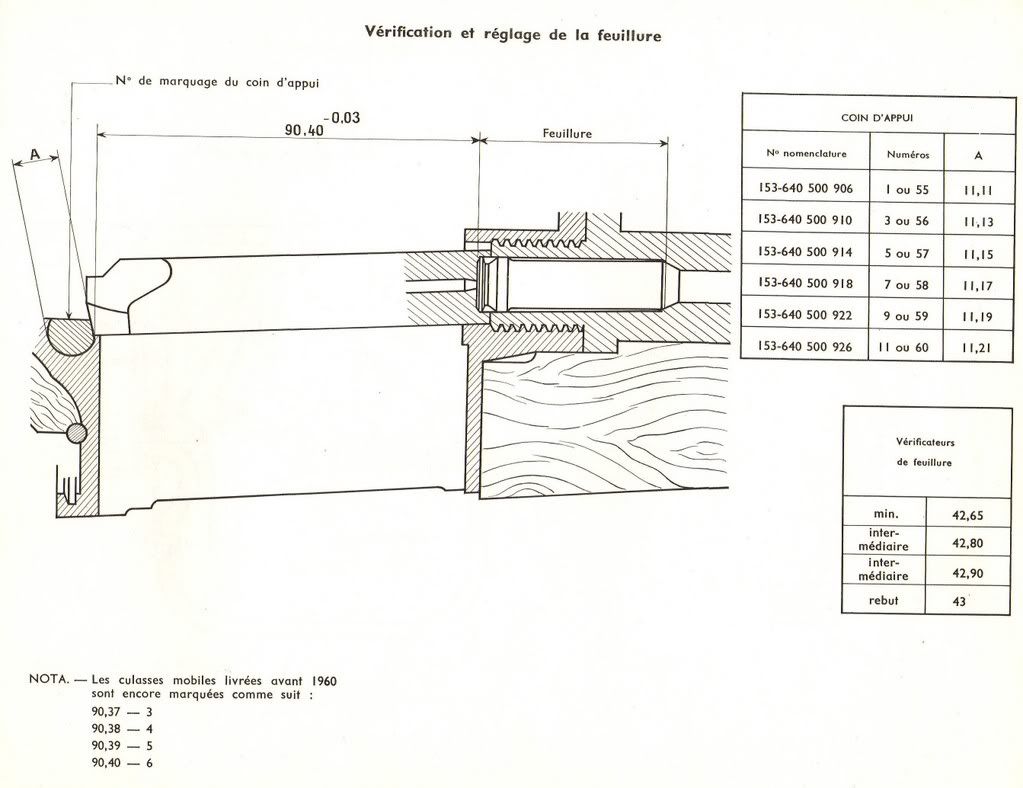 | |||
|
| One of Us |
I kind of get tired of those who are always slamming the French and their interesting, though sometimes peculiar firearms and the defeat of the French Army during WW II. The French Army wasn't really defeated; it was out fought and surrendered before it had a chance to attempt to recover. Whermacht soldiers firsthand accounts all say that when well led the French fought the Whermacht to a stand still. It was the maneuverability and tactics of the Whermacht that enabled it to succeed, not its superior fighting ability. The French Army was also hampered by a poor and outdated senior leadership that refused to think or act on any new tactics or weaponry that had been developed. Remember Napoleon? His army demonstrated how the French, or anyone else for that matter can fight if properly led. The American Union went from one defeat to another until a good leader changed the situation at Gettysburg. It isn't the soldier that’s poor, it's the leadership. My two cents. Regards, Eric "We must all hang together, or assuredly we shall all hang separately." Benjamin Franklin, July 4 1776 Lost once in the shuffle, member since 2000. | |||
|
| One of Us |
An interesting site among many http://www.germanwarmachine.com/campaigns/1940/battleoffrance1.htm Searching for Gembloux Gap battle brings very accurate reports on how the French fought. As it has been already said "Lions led by asses" and the Maginot line was not a stupid idea, it surrendered after the fall of France. The stupid thing is not having built it along the belgian border for political reasons and having confidence in the belgian forts on Maas river to stop the german assault. | |||
|
| One of Us |
Edmond, Could you please give me a weight estimate on that AR type conversion of the MAS? Thanks Joe | |||
|
| One of Us |
11 lbs. You're welcome. | |||
|
| One of Us |
The French designed and tested quantity of cartridges since the 1890, with bullet diameter from 6 to 8mm, case length from 54 to 63mm. These cartridges were used in semi auto rifles built in small quantities for field testing: 6x58 Meunier 1897 6x60 ENT 1900 6,5x60 CAP 6.,5x61 STA 6,5x55,5 Berthier 7X59 STA 1912 7x57 Meunier 1912 The 7x59 Meunier projectile had a speed over 1050 meter per second The 7x57 with a reduced load was retained for the Meunier A6 semi auto rifle adopted in 1913. MAT (Manufacture d'Armes de Tulle) produced 1000 rifles, 800 saw combat in 1914. It was too late to retool for a war that everybody predicted would last a few months... | |||
|
| One of Us |
| |||
|
| One of Us |
In fact it could be said that it was the Belgians, with their strict and foolish belief that their neutrality would "save" them that lost Western Europe in 1940. The Beligians were determined after 1939 that they would be 110% neutral. Thus neither British nor Frenc troops, or officers, were allowed into Belgium to either reconnoitre or pprepare defensive positions. The best of the French troops and the bulk of the British therefore had to sit on the Belgian border waiting for the inevitable German attack on Belgium. Once it came only then were they allowed to enter Belgium to assist the country in its defence. This was to work against them. It meant that more troops than would have been needed to defend Belgium if positions had been beuilt and occupied had to be committed. Therefore when the German blow fell through the Ardennes and around Sedan there were insufficient French troops to provide a proper defence. However, in the last event, in was the French that surrendered in June 1940 against the advice of Churchill who had advised a retreat to Brittany to form a "redoubt" to enable a re-grouping of forcres and then re-inforcement by Australian and Canadian troops on their way to Europe. France surrendered because they had hoped for a public statement of support from Franklin Roosevelt that he would not see France defeated. When Roosevelt would not, either privately or publicly give that support the French felt that they had to get the best "terms" from the Germans as they believed that they would be defeated and if they did not negotiate would loose all. Interestingly when I was at school learning about the "Fall of France" I asked my mother at the time if she was surprised and if it had come as a great shock in 1940. She said "No" her father had fought in the 1914-18 War alongside the French and opinion was that they were poor fighters then and no-one who had experience of that thought thay they would be any different in 1940! Tactically whilst the MAS 40 may have made a difference in the overall scheme of things it would not have mattered. Just as a British Army equipped with bolt action rifles and those same British, Polish, Free Fench, American and Canadian Armies equipped with the disgraceful and inferior Sherman Tank managed eventually to defeat the Germans in Western Europe. | |||
|
| One of Us |
Maybe you should go back to school... May 11, 2003 ONLY THE IGNORANT DARE CALL FRENCH COWARDS VERDUN, France - Something keeps drawing me back to this most evil and sinister battlefield on earth, a mere 18 km(10.8 miles) by 10 km (6 miles), where during ten hellish months of 1916 1.4 million French and German soldiers were killed or gravely wounded. Each year it is my custom to greet spring in France’s exquisite countryside, exploring battlefields and forts of the two world wars. But this, my sixth journey to Verdun, holds particular personal meaning. Decades of travel, covering many wars, reading the history of man’s folly have made me a cosmopolitan who detests borders and earnestly believes mankind’s worst evils are nationalism and religious fanaticism. Still, there are four countries that I hold particularly dear and to whom I feel respectful (as opposed to hormonal) patriotism, respect, and loyalty - Canada, France, Switzerland, the United States (in alphabetical, not emotional order), and reserve a special place for Pakistan. Quixotic as it may sound, while at Verdun, I apologized as a US Army veteran to France’s fallen soldiers for the slander and disgraceful lies hurled at their memory by American know-nothings and pro- Israel neo-con pundits who poured venom on the French for not agreeing to President George Bush’s imperial oil war against Iraq. ‘Defeat monkeys’….’surrender specialists’…..’never won a war’…’always saved by Americans’…’in war, like an accordion, useless and noisy..’ ‘cowards’ …were hurled at France by American commentators. The internet filled with anti-French jokes and lists of French military defeats. I invite all those flag waving, fire-breathing American couch patriots who called French cowards to visit Verdun. The air here still stinks of death; only deformed, stunted bushes grow on its poisoned soil. In the towering gray stone Ossuary repose bone pieces of 135,000 men. In 1916, the Germans sought to a decisive battle on the strategic heights above Verdun, where they planned to bleed France’s army to death with their massed artillery. On the first day of battle alone, French positions were inundated by one million heavy shells. The titanic bombardment went on for ten months, explosives against human flesh. Trenches and dugouts were pulverized. Entire French regiments were destroyed in hours. The French commander, Gen. Nivelle, ordered his 2nd Army defending Verdun: ‘No surrender; no retreat, not even an inch: die where you stand.’ And so they did. On 4-5 June, the Germans poured 100,000 poison gas shells - chlorine, phosgene, and cyanide - onto only 4 kms of French-held front - then launched divisional assaults against the position. French soldiers had no gasmasks. Thousands died in hideous agony, or were blinded. Yet they somehow held. Shells churned the battlefield into a gigantic quagmire of mud, rotting corpses, body parts, dead horses, overhung by a toxic miasma of chlorine and mustard gas. Troops went days without food; they drank from shell craters filled with bodies, and often drowned in them. German flamethrowers inflicted frightful casualties. Shells rained down round the clock. Every tiny elevation, every fort, became a little Thermopylae. At the height of the German attack on Fort Vaux, over 2,000 heavy shells an hour, some 405mm 1,000 kg monsters, were exploding each on its roof and glacis. When we today talk about soldier’s combat stress, think of the heroic garrison of Vaux, burned, gassed, poisoned by toxic smoke, dying of thirst, fearing they would be buried alive at any moment, yet fighting on. The French lost 100,000 casualties trying to retake another fort, Douaumont. Three-quarters of the French Army, an and entire generation of France’s men, passed through the inferno of Verdun. Units stayed in line until they had lost 60% casualties. Every town and village in France bears a war memorial with names of its sons fallen at Verdun. The heights above the Meuse River became France’s Calvary; ‘They shall not pass’ the army’s and nation’s credo. The attacking Germans fought, as always, like lions, losing 400,000 dead. They almost broke through, but were finally held at the last line of French defenses, at fearsome sacrifice. French soldiers fought like tigers, with their legendary fury and lan: over 430,000 died at Verdun; 800,000 were gassed or crippled for life. Bones are still unearthed here today, 87 years later; French metro’s and busses only recently ended reserved seating for ‘mutilated war veterans.’ After the war, there were not enough young Frenchmen to farm the fields or produce children. In the end, the French held Verdun. In this battle alone, France lost almost 1.5 times total US losses in all of World War II, and 20% of its nearly 2 million dead from 1914-1918. To the northwest of here is Sedan. In May, 1940, the German XIX Panzer Corps raced negotiated the dense Ardennes Forest and fought across the Meuse, dividing, then shattering the French Army. Italy attacked in the south. The French did not simply surrender, as some Americans claim. Their army fought valiantly, but was overwhelmed and torn apart by German’s high-tech military machine, just as Iraq’s outdated forces were recently obliterated by high-tech US forces. The French government wanted to fight on from Brittany, but there were no army divisions left intact. France lost 210,000 dead in 1940 fighting Germany and Italy; America lost 292,000 men during the entire war. Let’s keep the historical record accurate Eric Margolis | |||
|
| One of Us |
If you read German, I suggest you google Gembloux Panzerschlacht and read what the German HQ thought of the French. For English, press 1 http://www.axishistory.com/index.php?id=6699 1.1 The battle of Hannut (12th-14th May 1940) France • 411 tanks (including 176 Somua S35 and about 60 Hotchkiss with a 37mm L/33 SA38 gun) • 147 armored cars • 40 AT guns • 12 AA guns • 72 field guns • 6 infantry/motorcycle battalions Germany • 674 tanks (including 132 Panzer III and Panzer IV) • 112 armored cars • 165 AT guns (including 27 8.8cm FlaK L/56) • 72 AA guns • 108 field guns (including 72 10.5cm leFH sometimes used in direct fire against the French tanks) • 54 infantry guns • 14 infantry/motorcycle battalions The 3e DLM (general Langlois) will have to face directly 2 Panzerdivisionen : 3.PzD (general Stumpff) and 4.PzD (general Stever). The 2e DLM (general Bougrain) will be only partially implicated. Therefore the 674 German tanks including 132 Panzer III and Panzer IV will mainly be opposed to 239 French tanks including 88 Somua S35 tanks. On 10th May 1940, the reconnaissance elements of the 8e RC (colonel Mario) of the 2e DLM the 12e RC (colonel Leyer) of the 3e DLM moves towards the Meuse River, Liège and Maastricht. The core of the cavalry corps is moving to the area of Hannut. On 11th May, general Prioux choose to wait for the enemy on the Tirlemeont-Huy line, using the Petite Gette stream and the Méhaigne small river to anchor the defense. The north part behind the Petite Gette stream and Hannut is defended by the 3e DLM, which will have to face the main assault, and the south part behind the Méhaigne small river is defended by the 2e DLM. During the morning the Belgian army is retreating, exposing the flanks of the cavalry corps ; the actions of the different allies is not coordinated unlike the 136 German divisions under a same and efficient high command. The French reconnaissance patrols are in contact with the German armored elements between Maastricht and Liège. The area of the 3e DLM is divided in 2 sectors organized in depth with infantry strongpoints in each town, village or farm hold by the 11e RDP (colonel des Revouy) supported by tank groups deployed on the rear, ready to counter-attack between the infantry positions. The northern sector is defended by the 6e BLM (colonel des Loges) : • 12e RC (40 Panhard 178 armored cars) whose elements are currently in reconnaissance patrols • 11e RDP (2 infantry battalions with 44 Hotchkiss tanks) The 2nd battalion of the 11e RDP (II/11e RDP,captain Brau) is deployed around Ophelissem and the 3rd battalion of the 11e RDP (III/11e RDP,squadron commander Kientz) is around Marilles and Orp. The southern sector is defended by the 5e BLM (general de La Font) : • 1e RC (43 Hotchkiss H39 and 44 Somua S35) • 2e RC (43 Hotchkiss H39 and 44 Somua S35) • 11e RDP (1 infantry battalion with 22 Hotchkiss tanks) The first line around Hannut and Crehen is defended by the 1st battalion of the 11e RDP (I/11e RDP, capitaine Lafargue). The 2e RC (lieutenant-colonel Touzet du Vigier) has the task to protect this first line with 2 Somua S35 squadrons and 2 Hotchkiss H39 squadrons. The 1e RC (lieutenant-colonel de Vernejoul) is maintained in reserve in Jauche. The 2e DLM has also organized an in-depth defense with the 3 infantry battalions and the 67 AMR33 / AMR35 ZT1 armored cars of the 1e RDP (colonel de Bellefon) and the tanks of the 13e RD (lieutenant-colonel Juin de Baisse) and of the 29e RD (colonel Baruteau). 12th May 1940 The reconnaissance elements of colonel Leyer delay the 4.PzD until 12th May at 9h00 before moving back to the positions of the 6e BLM. The 4.PzD attacks, strongly supported by the VIII. Fliegerkorps (general von Richtofen) and its 342 Ju87 "Stuka" dive bombers. The Pz.Rgt.35 (colonel Eberbach) supported by 1 infantry battalion is the first to attack the French troops. The Hannut area is attacked by Panzergruppe Eberbach. The I/11e RDP holds and strikes back despite heavy losses mainly due to the 2.0cm guns of the Panzer II with their high rate of fire. The German tanks reached the center of the town. A first counter-attack is launched by the 3rd squadron of the 2e RC (Hotchkiss tanks, captain Sainte-Marie Perrin) : 11 French tanks and 5 German tanks are destroyed. The 10 other Hotchkiss tanks are ordered to retreat. The inefficiency of the 37mm SA18 L/21 gun of 80% of the Hotchkiss tanks is demonstrated ; it is unable to destroy the Panzer III and Panzer IV at 100m. In Crehen, the Somua S35 tanks (lieutenant Lotsisky) destroy 4 German tanks, 1 AT gun battery and several trucks. Next to Thisnes, despite heavy losses, the French troops stop the Germans and destroy the regimental command tank of colonel Eberbach (who will later be commander of the 4.PzD). The Somua S35 tanks launch a real charge against the enemy and stop the German advance in front of Crehen. Several German tanks are burning after the counter-attack of the Somua S35 tanks. At the end of the day, Crehen is evacuated by the French dragons portés who move back to Merdorp, Jandrenouille and Jandrain, on their second line. A renewed German assault is launched between Crehen and Hannut at 20h00, after a strong artillery preparation. A French artillery preparation is followed by the counter-attack of 1 Somua S35 tank squadron (only 21 tanks) of the 2e RC led by captain de Beaufort. The Somua S35 tanks destroy meticulously every German tank and resist to the German guns. This attack inflicts heavy losses to the Germans who are forced to retreat. Many Somua S35 tanks come back with 20-40 2.0cm and 3.7cm hits without any damage. The 4.PzD is also defeated more north on the Petite Gette stream, in front of Tirlemont. The German attempts to cross the Méhaigne river more south are defeated by the tanks of the 2e DLM which also supported the 3e DLM by firing on the tanks moving against the 3e DLM. During the rest of the night there are only artillery battles. During the night, General Hoepner realizes the inefficiency of his light tanks against the French tanks. He orders to engage the Hotchkiss tanks but to avoid combat with the Somua S35 tank. The French 47mm L/32 SA35 gun is able to destroy every German tank at 800-1000m but the the 3.7cm KwK proved to be rather useless at standard range (300-400m) against the Somua S35. The Somua S35 tanks will have to be neutralized by the Panzer III, Panzer IV and AT guns at close range and by the 8.8cm FlaK or 10.5cm leFH in direct fire at long range. 13th May 1940 On 13th May, the 3.PzD joins the 4.PzD. Nevertheless, at dawn the French troops are attacking and not the German ones. 6 Somua S35 platoons of the 2e DLM (30 tanks), led by captain de Villèle, attack at 5h30 the southern flank of the 4.PzD. They slaughtered German tanks and their losses were very small and mainly due to the use of 8.8cm FlaK in AT role. At 9h00, the Luftwaffe attacks massively Jauche, Merdorp and Jandrain. At 10h00, the German assault is launched. The German infantry clashes with the III/11e RDP and at 11h00 the tanks of the 3.PzD and 4.PzD attack concentrated on a front of less than 5 km wide. The 3.PzD towards Orp and the 4.PzD towards Jandrenouille. The French infantry strongpoints organized in hedgehogs are submerged, many Hotchkiss tanks are destroyed. At 13h30, the 1e RC (colonel de Vernejoul) which was maintained in reserve in Jauche in engaged. The 2nd squadron of the 1e RC (21 Somua S35 tanks, captain Ameil) is launched in a north to south attack against the 4.PzD positions north of Jandrenouille. The Somua S35 tanks stop, hull-down, at 800m of the German positions. All the German tanks are crowded in a forest edge. The Somua S35 tanks open fire and slaughter systematically the German tanks at long range. At the same time, the Somua S35 squadron led by captain de Beaufort (2e RC) launches a south to north counter-attack against the other flank of the 4.PzD. The 4.PzD looses many burning tanks and cannot deploy as it was planned. Elements of the 3.PzD are engaged to outflank the Somua S35 tanks of captain Ameil but on the way they encounter the 1st squadron (21 Somua S35, lieutenant Mazeran) of the 1e RC, perfectly embossed and engaging them on the flank. About 50 German tanks are knocked out but the Somua S35 tanks have to abandon their position because of lack of ammunition. Only lieutenant Racine's platoon manages to retreat without losses. 29 hits of 2.0cm and 3.7cm shells are numbered on his tank but without serious damage. Only 16 out of the 42 Somua S35 tanks of the 1e RC are still completely operational on 13th May evening, all covered with 20-40 impacts, the others have to be repaired or had been abandoned/destroyed. Many German shells had been wasted against the French tanks without success at a too long range. The 3.PzD is more lucky, most of the Somua S35 tanks being already engaged against the 4.PzD. General Stumpff commanding the 3.PzD, unlike the 4.PzD, doesn't try to reduce all the French infantry strongpoints but tries to infiltrate deeper. Nevertheless, several tanks remain stuck in the Petite Gette stream and several tanks are lost in front of the strongpoint of Marilles hold by the II/11e RDP. Lieutenant-colonel du Vigier (2e RC) engages against the 3.PzD his last 4 platoons : 10 Hotchkiss and 10 Somua S35 tanks. Jandrin is encircled, Jauche is close to the same fate but Marilles can be evacuated by the infantry under the cover of the French tanks. The 3e DLM is ordered to move back on new positions at 16h00 and the 2e DLM, far less engaged, at 17h00. The French 1st army is about 30 km behind but general Prioux has been ordered to delay the Germans until 14th May. The cavalry corps moves about 10 km back in the area of Perwez hold by the 4e GRDI (general Arlabosse), the reconnaissance group of the 15e DIM. The 4e GRDI includes motorcycle platoons but also 13 Laffly 50 AM and 12 Citroën-Kégresse P16 armored cars. There are no natural elements really useful to build a defense, only several dispersed and rather useless "Cointet" mobile AT obstacles. During this time the Luftwaffe attacks all the French rears, on the frontline the French and German troops are too closely mixed. Fuel supply issues force the XVI.Panzerkorps to stop on the Jauche – Ramilles line. At 21h00, the 3e DLM is deployed on its new positions and the 2e DLM is deployed early on 14th May. 14th May 1940 North of the French cavalry corps, the British troops move back behind the Dyle River. South of the French troops the Belgian army retreats on Bruxelles. Both flanks of the cavalry corps are exposed. During the morning the 3.PzD and 4.PzD attack strongly the center of the new French deployment, but they are defeated by the French artillery and perfectly embossed tanks. The 2e DLM and 3e DLM block the enemy until 15h00 when they start to move back behind the French 1st army around Gembloux. Mission accomplished for the cavalry corps of general Prioux. Germans never attacked with less than a tank battalion (about 80 tanks including 10 Panzer III and 6 Panzer IV) against French units of the strength of s squadron (about 20 tanks). The main reason is a better tactical regulation mainly due to more radio sets on the German side. French officers latter admitted that they were surprised by the German tank concentration. The French tanks due to their 1-man turret were probably a bit more intricate to use and were more often embossed in a rather static position, firing on the German tanks at medium/long range, than engaged in a pure melee-like combat. Contrary to the 1e DLM and 2e DLM who had well trained crews, the 3e DLM (except some officers from the other DLMs) had only reservists who did their military service on horse and some of them discovered their tank a short time before being engaged. They had fired a few shells at Suippes and now, they were facing a flood of German panzers ! (It is still amazing that they did not run away at this glance). To worsen the situation, most of the Somua of the 3e DLM went to combat with 2 crew members instead of 3, many tankers were in permission at the beginning of the combats and therefore nobody was there to help the commander to reload. In these tanks the Somua had really a 1-man turret instead of a 1 ½ one. This can explain why *one* German source (even not specified) is quoted in Gunsburg's article "battle of the Belgian plain" about the bad gunnery skills of the French tankers. The 3e DLM in Hannut which had a very high proportion of reservists sustained heavy losses while the more experienced crews of the 2e DLM (also less engaged) in the same battle had only light losses. Nevertheless the 3e DLM reservists inflicted significant losses to the elite of the Panzerwaffe. Each counter-attack made by a small formation of Somua S35 tanks was seen as critical by the Germans. For this division, there was of course the absence of tracer shells and the fact that grossly all the Hotchkiss tanks of the 3e DLM had 37mm SA18 L/21 guns with only poor anti-tank efficiency. It is a miracle that they could fight so well against the elite Panzerwaffe in Hannut. They had better tanks (considering the armor and the armament of the Somua S35 tanks) than most of the German crews but mostly with crews lacking training. To actually hit a Panzer with the 1-man turret would prove to be difficult for the 3e DLM : German tanks were fast, training insufficient and tracer shells absent in the tanks ... But on the German side, the situation was not very good as well : apart from the 7.5cm L/24 gun of the Panzer IV, no German shell could pierce the Somua S35 and the Hotchkiss H39 at a comfortable range, they had to move to close range. German tankers went to duel the French Somua S35 tanks at long range (around 800 to 1000m) with both sides using too many rounds for nothing but the 47mm L/32 SA35 gun of the Somua S35 was able to destroy the German tanks at this range unlike the German ones. The 4x gunsight of the Somua tanks was also adapted for such long range targeting. Even counterattacks led by 10 Somua S35 tanks were viewed as critical on the German side … The French would trade tanks for time. During the battle, the advancing German tanks were very often attacked on the flanks and the rear by the French tanks. The French tactics are therefore probably not that bad as often depicted. All along the battle, the French troops launched many counter-attacks despite being massively attacked by the Luftwaffe. The German colonel Neuman wrote : "the admirable tenacity of the French troops, which did not loose an inch of ground, despite heavy losses left the battle indecisive. General Hoepner didn't know the real strength of its opponent and the location of the core of the enemy armored forces." The losses are heavy on both sides. The French lost 105 tanks (75 Hotchkiss H35/H39 and 30 Somua S35 tanks) and the Germans about 164 tanks, mainly due to the action of the Somua S35 tanks (despite being often manned by crews lacking experience) but also several because of the Hotchkiss tanks or because of the infantry strongpoints including AT guns and AT mines. Concerning the French tank losses a good part was probably destroyed by the Luftwaffe and not at all by German tanks. A high proportion of the 75 Hotchkiss tanks was destroyed by enemy fire. A significant number of the 30 lost Somua S35 tanks is due to drivers' mistakes or mechanical breakdowns. Noteworthy here is nevertheless the 100% better survival rate of the more powerful Somua S35 tank compared to the Hotchkiss H39. Concerning the French infantry, the 11e RDP is reduced to 1 operational battalion. In tank battles, the one who hold the ground in the end has a tremendous advantage. Belgian civilians still remember that after the battle, German field workshops would work during the night to repair some of the tanks that were knocked out during the battle. 3 officers will be important during the next part of the war : colonel Leyer, future commander of the 4e DLM in June 1940, will be in 1942 in North-Africa one of the main actors of the creation of the French armored arm. Colonel Touzet du Vigier and colonel de Vernejoul will both command an armoured division for the liberation of France | |||
|
| One of Us |
Churchill "The Second World War" Vol. 3 "The Fall of France": On 13 June 1940 I made my last visit to France for four years almost to a day. The French Government had now withdrawn to Tours. Arrived over Tours, we found the airport had been heavily bombed the night before, but we and all our escort landed smoothly in spite of the craters. We borrowed a service car from the station commander and motored into the city, making for the Prefecture, where it was said the French Government had their headquarters. M. Reynaud, the French President, arrived. General Weygand had reported to him that the French Armies were exhausted. The line was pierced in many places; refugees were pouring along al roads through the country, and many of the troops were in disorder. The Generalissimo felt it was necessary to ask for armistice while there were still enough French troops to keep order until peace could be made. Such was the military advice. He would send that day a further message to Mr. Roosevelt saying that the last hour had come and that the fate of the Allied cause lay in America's hand. Hence arose the alternative of armistice and peace. M. Reynaud proceeded to say that the Council of Ministers had on the previous day instructed him to inquire what would be Britain's attitude should the worst come. He himself was well aware of the solemn pledge that no separate peace would be entered into by EITHER Britain or France. General Weygand and others pointed out that France had already sacrificed everything in the common cause. She had nothing left. It would in those circumstances be a shock if Britain failed to concede that France was physically unable to carry on, if France was still expected to fight on and tus deliver up her people to the certainty of corruption and evil transformation at the hands of ruthless specialists in the art of bringing conquered people to heel. That was the question which had to be put. Would Great Britain realise the hard facts with which France was faced? Churchill replied they would therefore hope that France would carry on fighting south of Paris down to the sea, and if need be from North Africa. At all costs time must be gained. The alternative course meant destruction for France quite as certainly. Hitler would abide by no pledges. If on the other hand France remained in the struggle, with her fine Navy, her great Empire, her army carried on guerilla warfare on a gigantic scale, and if Germany failed to destroy England, which she must do or go under, if then Germany's might in the air was broken, then the whole hateful edifice of Nazidom would topple over. At all events England would fight on. She had not and would not alter her resolve: no terms, no surrender. The alternatives were death or victory. That was my answer to M. Reynaud. M. Reynaud replied that he had never doubted England's determination. He was however anxious to know how the British Government would react in a certain contigency. The French Government - the present one or another - might say we know you will carry on. We would also, if we saw any hope of victory. But we see no sufficient hopes of an early victory. We cannot count on American help. There is no light at the end of the tunnel. We cannot abandon our people to indefinite German domination. We must come to terms. We have no choice. It was already too late to organise a redoubt in Brittany. Would Churchill acknowledge that France has given her best, that she can do no more. That she is entitled, having nothing further to contribute to the common cause, to enter into a separate peace while maintaining the solidarity implicit in the solemn agreement entered into three months previously? Churchill said that in no case Britain would waste time and energy on reproaches and recriminations. That did not mean that she would consent to action contrary to the recent agreement. Britain would not agree to a separate peace however it might come. Our war aim remained the total defeat of Hitler and we felt that we could still bring this about. We were therefore not in a position to release France from her obligations. Whatever happened, we would level no reproaches against France; but that was a different matter from consenting to release her from her pledge. Before leaving I made one particular request to M. Reynaud. Over four hundred German pilots, the bulk of whom had been shot down by the RAF, were prisoners in France. Having reagrd to teh situation, they should be handed over to our custody. M. Reynaud willingly gave this promise, but soon he had no power to keep it. These German pilots all became available for the Battle of Britain, and we had to shoot them down a second time. | |||
|
| One of Us |
about the pilots, untrue. The RAF did not shot much Germans.. Unlike the BS spread everywhere, search for the way the Luftwaffe suffered from the French Air Force D-520 and other planes flown with maestria by the French. About fighting from the French Empire, BS again. There was no arsenal, no ammo producing capacity, no military installations outside of metropolitan France. | |||
|
| One of Us |
| |||
|
| one of us |
Edmond; Good to see you. Those rifles look there's a good bit of steel to machine off before final production. Please excuse my laziness; Is the French 7.5 the same cartridge as the Swiss or Jap.? I think the Swiss had a 7.5? Good to see you again. Jim "Whensoever the General Government assumes undelegated powers, its acts are unauthoritative, void, and of no force." --Thomas Jefferson | |||
|
| One of Us |
Hi Jim No 7.5x54 mm MAS is different from Swiss GP 11 round that is a 7.5x55 mm with a complete different case diameter or the Jap round. | |||
|
| one of us |
French developments --I was once told that the first electric heating system was in the Maginot line . Anyone know if that's correct ?? | |||
|
| One of Us |
After WW2. everything was electric except heating, before WW2. Heating was mainly water/air exchange through pulsed air, boilers (coal or wood) supplied heating as well as the cooling system for the engines (air filtration, used water pumps, electric generators) | |||
|
| One of Us |
Sorry Edmond, you were doing OK until the posting of the 'imperial oil war against Iraq' crapola (and that is TOTAL crapola, by the way). Face it, although the French fought bravely in both WWI and WWII France would not be a nation today without American intervention in both wars. Of course, the USA would not be a nation today without French intervention in the Revolutionary war. Back to the rifle: it seems to be a case of 'too little too late'. Have you ever shot one or is possession banned in France? | |||
|
| one of us |
Edmond I have not shot one of those. I have handled the bolt rifle, so I can somewhat know how the semiauto would handle. It seems to be slim and trim. I would like to shoot one of them some day. However, I will add that even today the M1 Garand is a MOST popular rifle today in the USA. But I will aslo concede that becaue of "things" in Europe, I would assume that most of those rifles were destroyed, [what a pity],as it was not even considered to EVER let civilians get/buy them. DOUBLE RIFLE SHOOTERS SOCIETY | |||
|
| One of Us |
Take advantage of the fact people do not know them good, add the "never fired, dropped once" factor and you can find some of them in pawn shops and gun shows or advertising. You will not regret you did and 7.5 ammo is everywhere in US. Same projectiles as .308 Win / 7.62 NATO, 125 to 160 grains have the best results. | |||
|
| one of us |
Used to own one. Grizz Indeed, no human being has yet lived under conditions which, considering the prevailing climates of the past, can be regarded as normal. John E Pfeiffer, The Emergence of Man Those who can't skin, can hold a leg. Abraham Lincoln Only one war at a time. Abe Again. | |||
|
| Powered by Social Strata |
| Please Wait. Your request is being processed... |
|
 The Accurate Reloading Forums
The Accurate Reloading Forums  THE ACCURATE RELOADING.COM FORUMS
THE ACCURATE RELOADING.COM FORUMS  Guns, Politics, Gunsmithing & Reloading
Guns, Politics, Gunsmithing & Reloading  Military & Military Surplus
Military & Military Surplus  French MAS 1940, the most modern semi auto rifle in WW2
French MAS 1940, the most modern semi auto rifle in WW2

Visit our on-line store for AR Memorabilia

